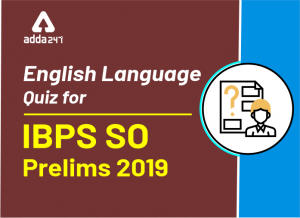English Section is a topic that is feared by most of the candidates appearing in the IBPS SO and IBPS Clerk Mains Exam. Though the sheer number of concepts and rules may seem intimidating at first, with discipline and the right approach, it is not difficult to master these concepts and their application to questions. Through such English Quizzes for IBPS Clerk, IBPS SO and other upcoming exams, we will provide you with all types of high-level questions to ace the questions based on new pattern English for IBPS SO and IBPS Clerk Mains.
Directions (1-10): Read the following passage carefully and answer the questions given below it. Certain words are given bold to help you to locate them while answering some of the questions.
To summarize the Classic Maya collapse, we can tentatively identify five strands. I acknowledge, however, that Maya archaeologists still disagree vigorously among themselves—in part, because the detailed archaeological studies are available for only some Maya sites: and because it remains puzzling why most of the Maya heartland remained nearly empty of population and failed to recover after the collapse and after re-growth of forests.
With those caveats, it appears to me that one strand consisted of population growth outstripping available resources: a dilemma similar to the one foreseen by Thomas Malthus in 1798 and being played out today in Rwanda, Haiti, and elsewhere. As the archaeologist David Webster succinctly puts it, “Too many farmers grew too many crops on too much of landscape.” Compounding that mismatch between population and resource was the second strand: the effects of deforestation and hillside erosion, which caused a decrease in the amount of useable farmland at a time when more rather than less farmland was needed, and possibly exacerbated by an anthropogenic drought resulting from deforestation, by soil nutrient depletion and other soil problem, and by the struggle to prevent bracken ferns from overrunning the fields.
The third strand consisted of increased fighting, as more and more people fought over fewer resources. Maya warfare, already endemic, peaked just before the collapse. That is not surprising when one reflects that at least five million people, perhaps many more, were Crammed into areas smaller than US state of Colorado (104,000 square miles). That warfare would have decreased further the amount of land available for agriculture, by creating no-man’s lands between principalities where it was now unsafe to farm. Bringing matters to a head was the strand of climate change. The drought at the time of the Classic collapse was not the first drought that the Maya had lived through, but it was the most severe. At the time of previous drought there were still uninhabited parts of Maya landscape, and people at a site affected by drought could save themselves by moving to another site. However, by the time of the classic collapse the landscape was now full; there was no useful unoccupied land in the vicinity on which to begin anew, and the whole population could not be accommodated in the few that continued to have reliable water supplies.
As our fifth strand, we have to wonder why the kings and nobles failed to recognize and solve these seemingly obvious problems undermining their society. Their attention was evidently focused on their short-term concerns of enriching themselves, waging wars, erecting monuments, competing with each other, extracting enough food from the peasants to support all those activities. Like most leaders throughout human history, the Maya kings and nobles did not heed long-term problems, in so far as they perceived them.
Finally, while we still have some other past societies to consider before we switch our attention to the modern world, we must already be struck by some parallels between the Maya and the past societies. As on Mangareva, the Maya environmental and population problems led to increasing warfare and civil strife. Similarly, on Easter Island and at Chaco Canyon, the Maya peak population numbers were followed swiftly by political and social collapse. Paralleling the eventual of agriculture from Easter Island’s coastal lowland to its uplands, and from the Mimbres extension floodplain to the hills, Copan’s inhabitants also expanded from the floodplain to the more fragile hill slope, leaving them with a larger population to feed when the agricultural boom in the hills went bust. Like Easter Island chiefs erecting ever larger statues, eventually crowned by pukao, and like Anasazi elite treating themselves to necklaces of 2,000 turquoise beads, Maya kings sought to outdo each other with more impressive temples, covered with thicker and thicker plaster—reminiscent in turn of the extravagant conspicuous consumption by modern American CEOs. The passivity of Easter chiefs and Maya kings in the face of the real big threats to their societies completes our list of disquieting parallels.
Q1. According to the passage, which of the following best represents the factor that has been cited by the author in the context of Rwanda and Haiti?
(a) Various ethics groups competing for land and other resources.
(b) Various ethics groups competing for limited land resources.
(c) Various ethics groups fighting with each other.
(d) Various ethics groups competing for political power.
(e) Various ethics groups fighting for their identity.
Q2. By an anthropogenic drought, the author means
(a) A drought caused by lack of rains.
(b) A drought caused due to deforestation.
(c) A drought caused by failure to prevent bracken ferns from overrunning the fields.
(d) A drought caused by actions of humans beings.
(e) A drought caused by climate changes.
Q3. According to the passage, the drought at the time of Maya collapse had a different impact compared to the droughts earlier because.
(a) The Maya kings continued to be extravagant when common people were suffering.
(b) It happened at the time of collapse of leaderships among Mayas.
(c) It happened when the Maya population had occupied all available land suited for agriculture.
(d) It was followed by internecine warfare among Mayans.
(e) Irreversible environmental degradation led to this drought.
Q4. According to the author, why is it difficult to explain the reason for Maya Collapse?
(a) Copan inhabitants destroyed all records of that period.
(b) The constant deforestation and hillside erosion have wiped out all trace of the Maya kingdom.
(c) Archaeological sites of Mayas do not provide any consistent evidence.
(d) It has not been possible to ascertain which of the factors best explains as to why the Maya civilization collapsed.
(e) At least five million people were crammed into small area.
Q5. Which factor has not been cited as one of the factors causing the collapse of Maya society?
(a) Environmental degradation due to excess population.
(b) Social collapse due to excess population.
(c) Increased warfare among Maya people.
(d) Climate change.
(e) Obsession of Maya population with their own short-term concerns.
Q6. Which of the following is most nearly similar in meaning of the word Succinctly as used in the passage?
(a)permanently
(b)sophisticated
(c)verbose
(d)saddle
(e)brief
Q7. Which of the following is most nearly similar in meaning of the word Endemic as used in the passage?
(a)illegal
(b)regional
(c)ending
(d)expatriate
(e)transplanted
Q8. Which of the following is most nearly similar in meaning of the word Crammed as used in the passage?
(a)crack
(b)stuffed
(c)casual
(d)wanting
(e)stark
Q9. Which of the following is most nearly opposite in meaning of the word Extension as used in the passage?
(a)prolongation
(b)lengthening
(c)elongation
(d)annex
(e) abridgment
Q10. Which of the following is most nearly opposite in meaning of the word Reminiscent as used in the passage?
(a)nostalgic
(b)mnemonic
(c)redolent
(d)oblivious
(e)evocative
Direction (11-15): In each question, the word at the top is used in five different ways, numbered A to E, Choose the option in which the usage of the word is INCORRECT or INAPPROPRIATE.
Q11. Turn
(a)We turned around in someone’s driveway.
(b)You need to turn your life around before it’s too late.
(c)All the seats were sold and a large crowd had to be turned away.
(d)She turned the offer .
(e)It’s too late to turn back. We have to keep going.
Q12. Stand
(a)I’ll stand behind you no matter what you decide to do.
(b)A group of students stood by and watched the boys fight.
(c)She stood by her husband throughout the trial.
(d)He can’t be here today, so he asked me to stand over.
(e) His bright tie made him stand out
Q13. Put
(a)He washed, dried, and put away the dishes after dinner.
(b)The books had been put back neatly on the shelf.
(c)She carefully put the vase down on the table.
(d)She has put some money by for emergencies.
(e)We should put this question the voters.
Q14. Give
(a)He virtually gave the election away when he made a racist remark.
(b)He gave back the money he found to the person who’d lost it.
(c)They agreed to give him his old job back.
(d)The strike has been going on for weeks, and neither side seems willing to give in.
(e) The chimneys gave on thick, black smoke.
Q15. GO
(a)It’s going to be cold tomorrow.
(b)When the boy ran out the door, his mother quickly went after him.
(c)Everything seemed to be going against her but she didn’t give up hope.
(d)Despite the weather, the party went as planned.
(e)The government is going after people who cheat on their taxes.




 English Quiz IBPS SO Prelims: 16th Decem...
English Quiz IBPS SO Prelims: 16th Decem...



